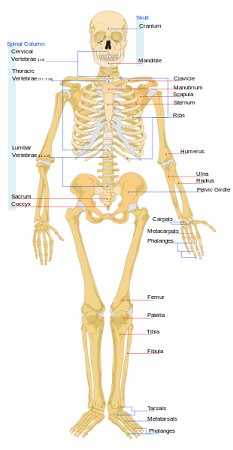Human anatomy and physiology refer to the study of the structure and functions of the human body. Anatomy specifically refers to the structure and relationships between body parts, while physiology refers to the function of the body parts and the body as a whole. The discipline of anatomy can further be broken down to macroscopic (or gross) anatomy and microscopic anatomy. Macroscopic anatomy refers to the study of visible body parts, including those which can be seen when dissected. Microscopic anatomy refers to the study of structures at a microscopic level, including Histology – the study of tissues, Cytology – the study of cells, and Neurophysiology – the study of how the nervous system works.
Specific areas of study within anatomy and physiology include the:
- Skeletal system
- Muscular system
- Cardiovascular system
- Digestive system
- Endocrine system
- Nervous system
- Respiratory system
- Immune/lymphatic system
- Urinary system
- Reproductive system
- Integumentary systems (an organ system consisting of the skin, hair, nails, and exocrine glands)
Methods for understanding the structure and functions of the human body have improved dramatically over the years. Beginning methods included the examination of animals and the through dissection of cadavers, to the use of X-rays, ultrasounds, and magnetic resonance imaging (MRI).

Image Credit: [Wikimedia Commons] - Skeletal System
Image Credit: [Wikimedia Commons] - Muscular System

Image Credit: [Wikimedia Commons] - Endocrine System
References:
Anatomy. (n.d.) Retrieved February 6, 2014 from Wikipedia the Free Encyclopedia: http://en.wikipedia.org/wiki/Anatomy
Cliff Notes. (n.d.) What is Anatomy and Physiology? Retrieved from http://www.cliffsnotes.com/sciences/anatomy-and-physiology/anatomy-and-chemistry-basics/what-is-anatomy-and-physiology
Inner Body. (n.d.) Anatomy Systems. Retrieved from http://www.innerbody.com/
© BrainMass Inc. brainmass.com June 30, 2024, 9:22 am ad1c9bdddf